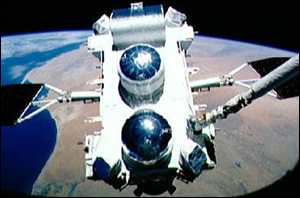
It was brought down in a remote part of the Pacific Ocean after being sent orders to destroy itself by the US space agency Nasa.
The satellite, the size of a bus, was taken out of commission because of fears it could have plummeted to Earth in an uncontrolled re-entry over a populated area.
Engineers at the Goddard Space Flight Center in Maryland started sending signals to the satellite on Tuesday to perform a series of rocket firings that eventually dropped the observatory into the ocean on Sunday morning.
"We got a positive confirmation," said mission re-entry director Tom Quinn. "A job well done."
Longer than expected
The debris rained down on an area of the Pacific some 4,000 km (2,500 miles) southeast of Hawaii. Shipping and air traffic had been warned to stay away
A US Air Force observation plane reported sighting pieces of the spacecraft falling into the ocean, Nasa officials said.
The 15-tonne satellite had been gathering information about the Universe in the high-energy end of the electromagnetic spectrum for nearly a decade. This was much longer than the initial life expectancy of only two years.
The heaviest science satellite ever put into orbit, Compton provided astronomers with a wealth of data.
But last December, one of its two stabilising gyroscopes broke down.
Skylab re-rentry
Rather than risk an uncontrolled crash, like that of the Skylab space station in 1979 which rained debris on Australia, Nasa decided to bring the observatory down in the emptiest part of the South Pacific.
Compton's record
First major space observatory to study invisible gamma rays
Detected 2,600 gamma ray bursts
Found hundreds of unknown gamma ray sources
Discovered 30 objects which remain unexplained
Changed the way astronomers view the Universe
Spawned 2,000 scientific papers
It was the first time that Nasa had deliberately destroyed a functional satellite, and the move angered some of those who have spent the past 20 years working on the Gamma Ray programme.
They urged Nasa to keep working with the observatory.
But the space agency said it could not risk the lives of those on Earth who lived under the observatory's orbit, even for the sake of science.
A projection showed that if Nasa did nothing, the craft would have eventually fallen on its own from space, with a one-in-1,000 chance of killing someone on Earth.
The craft's orbit took it over some of the most populated areas of the world, including Mexico City, Miami and Bangkok.
'Profoundly saddened'
Unlike most satellites, the Compton Gamma Ray Observatory was too large to burn up entirely as it passed through the Earth's atmosphere.
The observatory's findings helped the study of black holes
The scientists who had worked on its data mourned the loss.
"This is a painful time for scientists who have used Compton for the last nine years," said project scientist Dr Neil Gehrels.
"The entire scientific community is disappointed. I was profoundly saddened."
The satellite was designed to study some of the most powerful phenomena in the Universe.
When stars explode, they emit gamma rays which can travel enormous distances over billions of years, giving scientists clues about the birth of the Universe.
Every day, new sources of gamma radiation are discovered, and the satellite has been sending streams of data back to Earth.

